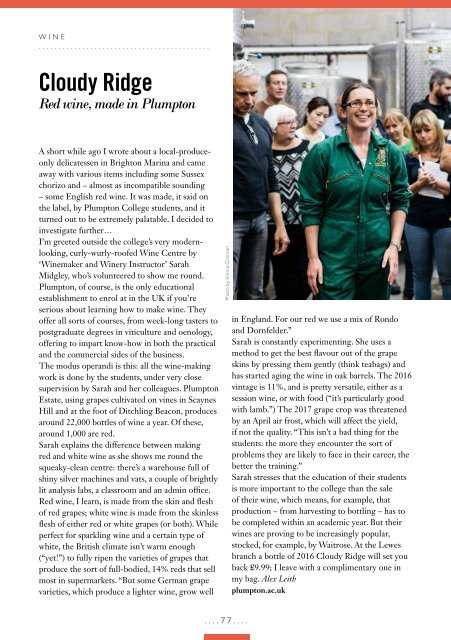Viva Brighton Issue #56 October 2017
You also want an ePaper? Increase the reach of your titles
YUMPU automatically turns print PDFs into web optimized ePapers that Google loves.
WINE<br />
...........................................<br />
Cloudy Ridge<br />
Red wine, made in Plumpton<br />
A short while ago I wrote about a local-produceonly<br />
delicatessen in <strong>Brighton</strong> Marina and came<br />
away with various items including some Sussex<br />
chorizo and – almost as incompatible sounding<br />
– some English red wine. It was made, it said on<br />
the label, by Plumpton College students, and it<br />
turned out to be extremely palatable. I decided to<br />
investigate further…<br />
I’m greeted outside the college’s very modernlooking,<br />
curly-wurly-roofed Wine Centre by<br />
‘Winemaker and Winery Instructor’ Sarah<br />
Midgley, who’s volunteered to show me round.<br />
Plumpton, of course, is the only educational<br />
establishment to enrol at in the UK if you’re<br />
serious about learning how to make wine. They<br />
offer all sorts of courses, from week-long tasters to<br />
postgraduate degrees in viticulture and oenology,<br />
offering to impart know-how in both the practical<br />
and the commercial sides of the business.<br />
The modus operandi is this: all the wine-making<br />
work is done by the students, under very close<br />
supervision by Sarah and her colleagues. Plumpton<br />
Estate, using grapes cultivated on vines in Scaynes<br />
Hill and at the foot of Ditchling Beacon, produces<br />
around 22,000 bottles of wine a year. Of these,<br />
around 1,000 are red.<br />
Sarah explains the difference between making<br />
red and white wine as she shows me round the<br />
squeaky-clean centre: there’s a warehouse full of<br />
shiny silver machines and vats, a couple of brightly<br />
lit analysis labs, a classroom and an admin office.<br />
Red wine, I learn, is made from the skin and flesh<br />
of red grapes; white wine is made from the skinless<br />
flesh of either red or white grapes (or both). While<br />
perfect for sparkling wine and a certain type of<br />
white, the British climate isn’t warm enough<br />
(“yet!”) to fully ripen the varieties of grapes that<br />
produce the sort of full-bodied, 14% reds that sell<br />
most in supermarkets. “But some German grape<br />
varieties, which produce a lighter wine, grow well<br />
Photo by Emma Croman<br />
in England. For our red we use a mix of Rondo<br />
and Dornfelder.”<br />
Sarah is constantly experimenting. She uses a<br />
method to get the best flavour out of the grape<br />
skins by pressing them gently (think teabags) and<br />
has started aging the wine in oak barrels. The 2016<br />
vintage is 11%, and is pretty versatile, either as a<br />
session wine, or with food (“it’s particularly good<br />
with lamb.”) The <strong>2017</strong> grape crop was threatened<br />
by an April air frost, which will affect the yield,<br />
if not the quality. “This isn’t a bad thing for the<br />
students: the more they encounter the sort of<br />
problems they are likely to face in their career, the<br />
better the training.”<br />
Sarah stresses that the education of their students<br />
is more important to the college than the sale<br />
of their wine, which means, for example, that<br />
production – from harvesting to bottling – has to<br />
be completed within an academic year. But their<br />
wines are proving to be increasingly popular,<br />
stocked, for example, by Waitrose. At the Lewes<br />
branch a bottle of 2016 Cloudy Ridge will set you<br />
back £9.99; I leave with a complimentary one in<br />
my bag. Alex Leith<br />
plumpton.ac.uk<br />
....77....


















